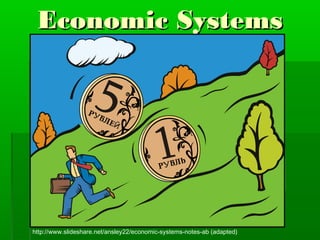
Economic systems
- 2. Economic Systems How a country’s economy is organized Because of the problem of scarcity, every country needs a system to determine how to use its productive resources An economic system must answer 3 basic questions…
- 3. WHAT TO PRODUCE? (What kinds of goods and services should be produced?) HOW TO PRODUCE? (What productive resources are used to produce goods and services?) FOR WHOM TO PRODUCE? (Who gets to have the goods and services? The way a society answers these questions determines its economic system.
- 4. 4Types of Economic Systems: 1. Traditional Economy 2. Command Economy 3. Market Economy 4. Mixed Economy (Market + Command )
- 5. Traditional Economy An economic system in which economic decisions are based on customs and beliefs People will make what they always made & will do the same work their parents did Exchange of goods is done through bartering: trading without using money
- 6. Traditional Economy Who decides what to produce? People follow their customs and make what their ancestors made Who decides how to produce goods & services? People grow & make things the same way that their ancestors did Who are the goods & services produced for? People in the village who need them
- 7. Traditional Economy Examples: Villages in Africa and South America; the Inuit tribes in Canada; the caste system in parts of rural India
- 8. Command System Government makes all economic decisions & owns most of the property Governmental planning groups determine such things as the prices of goods/services & the wages of workers This system has not been very successful & more and more countries are abandoning it
- 9. Command Economy Who decides what to produce? Government makes all economic decisions Who decides how to produce goods and services? Government decides how to make goods/services Who are the goods and services produced for? Whoever the government decides to give them to
- 10. Command System Countries with communist governments have Command economies Examples: Cuba, former Soviet Union, North Korea *Germany and Russia have moved away from having a Command economy since 1991. Now they have a Mixed economy.
- 11. Market Economy An economic system in which economic decisions are guided by the changes in prices that occur as individual buyers and sellers interact in the market place Most of the resources are owned by private citizens Economic decisions are based on Free Enterprise (competition between companies) Important economic questions are not answered by gov. but by individuals Gov. does not tell a business what goods to produce or what price to charge
- 12. Market Economy Who decides what to produce? Businesses base decisions on supply and demand and free enterprise (PRICE) Who decides how to produce goods and services? Businesses decide how to produce goods Who are the goods and services produced for? Consumers
- 13. Market Economy There are no truly pure Market economies, but the U.S. is close.
- 14. Mixed Economy Market + Command = Mixed There are no pure command or market economies. To some degree, all modern economies exhibit characteristics of both systems and are often referred to as mixed economies. Most economies are closer to one type of economic system. than another Businesses own most resources and determine what and how to produce, but the Government regulates certain industries
- 15. Mixed Economy Who decides what to produce? Businesses Who decides how to produce goods & services? Businesses, but the government regulates certain industries Who are goods & services produced for? Consumers
- 16. Mixed Economy Most democratic countries fall into this category (there are no truly pure Market or Command economies). Examples: Brazil, Mexico, Canada, UK, etc.
- 17. Which Economic System Is Best? Market system - proven to be the best. It promotes the goals of growth, freedom, & efficiency Citizens are free to own their own property & use it more efficiently & profitably Command & Traditional systems sometimes offer more security, but are not as strong in efficiency, growth, freedom, and environmental quality
